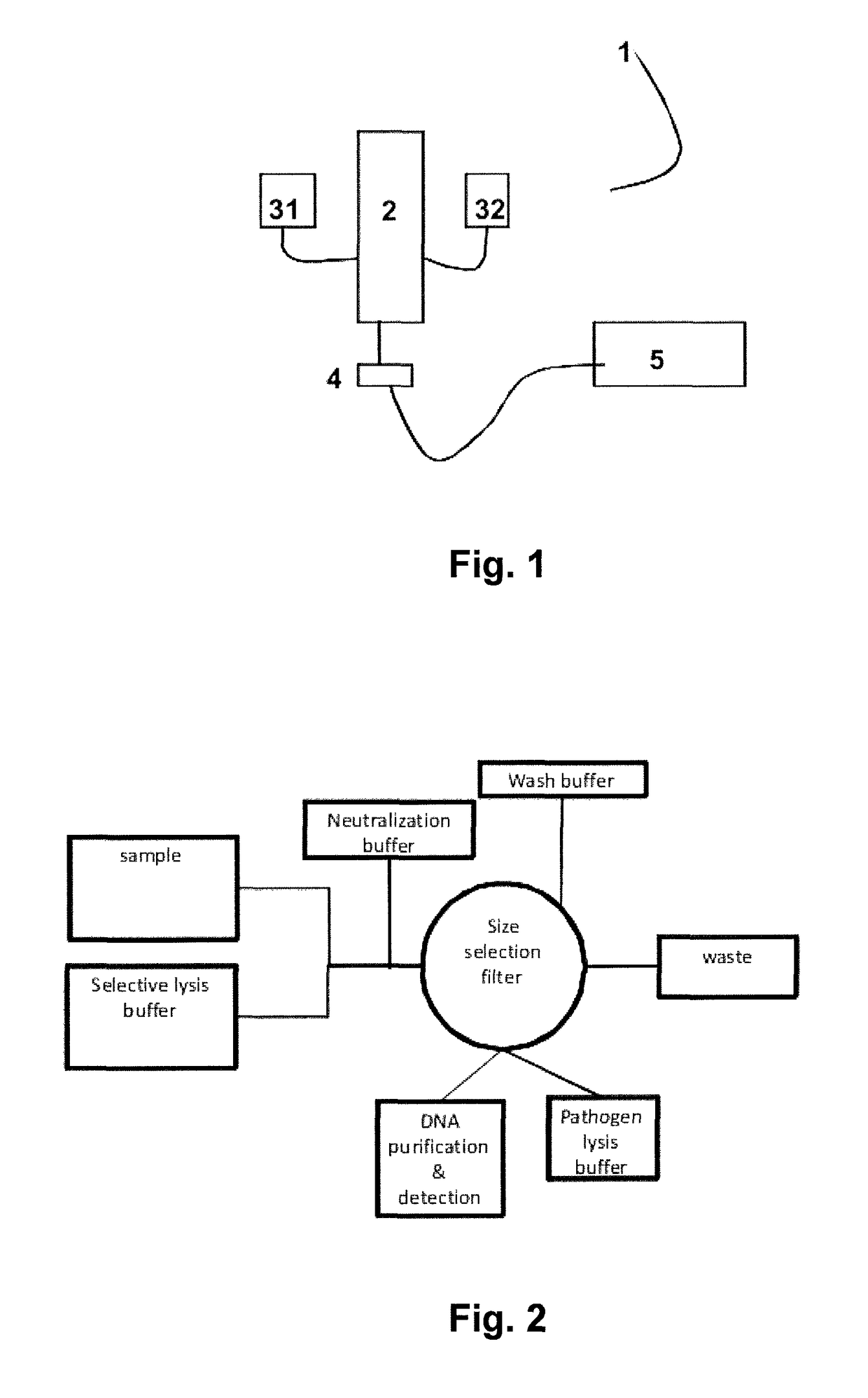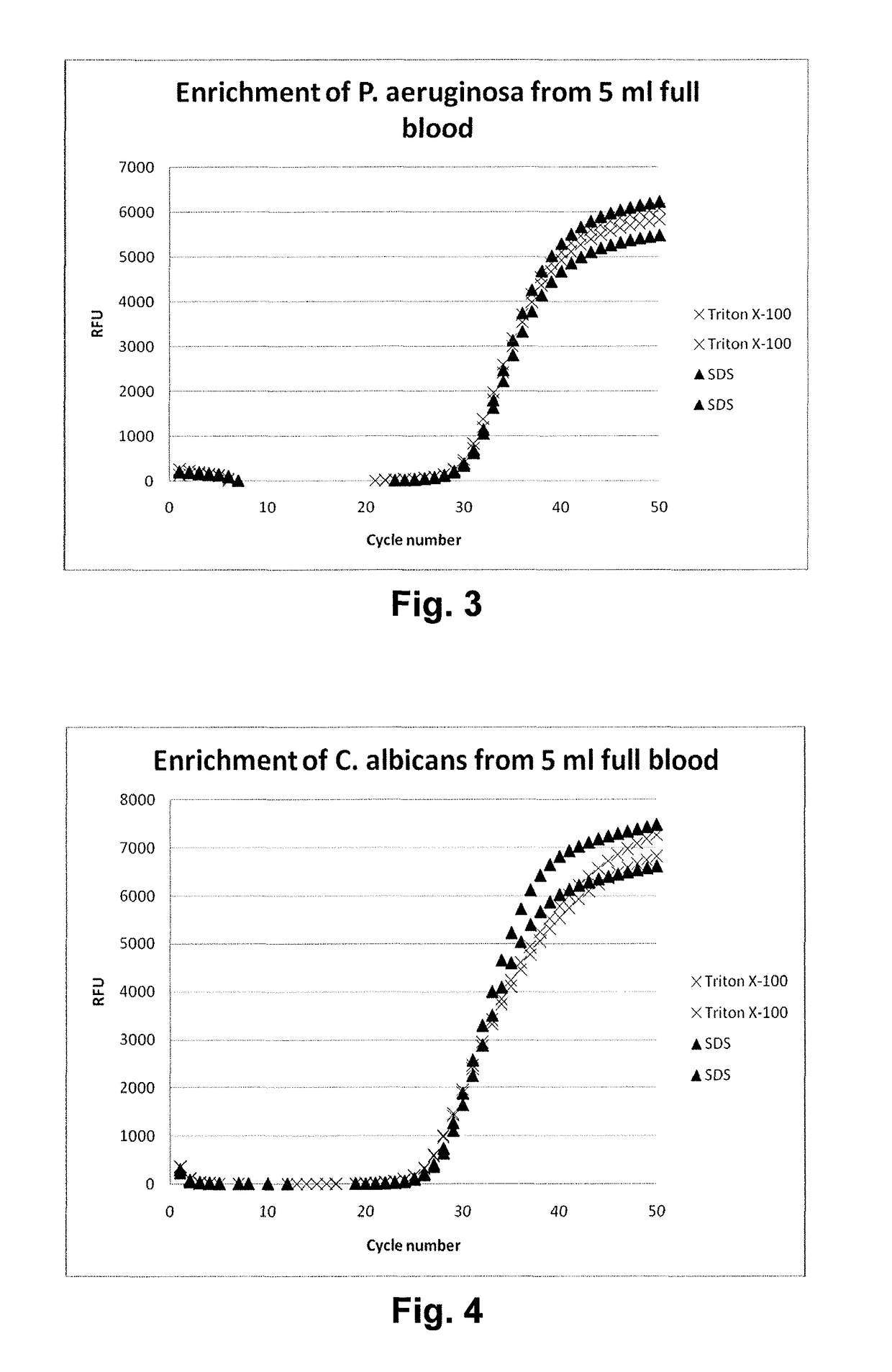Selective lysis of cells by ionic surfactants
a technology of surfactants and lysis of cells, applied in the field of eukaryotic cell lysis, can solve the problems of large volume of blood, difficult to detect the presence of about 10 to 100,000 bacteria in a volume of 10 ml of whole blood, and complex composition, etc., to achieve the effect of less complex, low viscosity, and large volume of sampl
- Summary
- Abstract
- Description
- Claims
- Application Information
AI Technical Summary
Benefits of technology
Problems solved by technology
Method used
Image
Examples
example 1
[0066]Recovery of Micro-organisms from Blood Samples
[0067]About 1.000 colony forming units (cfu) of either Pseudomonas aeruginosa or Candida albicans were spiked in each 5 ml sample of human whole blood. An equal volume of lysis buffer (500 mM Na carbonate (pH 10.0) and either 1.0% Triton X-100 (final concentration) or 1% sodium dodecyl sulfate (final concentration) was added and the mixture was incubated for 3 minutes at room temperature (about 23° C.).
[0068]After the incubation the lysed sample was neutralized with a 1 M Tris solution to restore the pH. The samples were centrifuged and washed with 1 ml phosphate-buffered saline (PBS). Hereafter the micro-organisms were lysed by adding pre-heated 200 mM NaOH, 1% SDS and their DNA was purified using standard silica spin columns after the eluates were neutralized with 1 M citric acid.
example 2
[0069]Detection of Microbial DNA
[0070]For elution from the filter and for alkaline lysis of the micro-organisms, the microbial cells were resuspended in 100 μl of a lysis solution containing 50 mM NaOH and 0.25% SDS. Subsequently the samples were incubated for 10 min at 70° C., cooled quickly to room temperature and neutralized by addition of 30 μl 500 mM Tris-HCl, pH 7.0 (yielding a final concentration of 150 mM Tris, i.e. 3 times the NaOH concentration).
[0071]For crude lysate PCR, unlysed cells and debris were removed from the sample by centrifugation (5 min, 14,000 g). 1 μl of supernatant was added to a 25 μl PCR reaction. Detection by PCR was based on a Taqman PCR assay targeting the rRNA gene (Apollo). The PCR reaction was conducted in Taqman Universal mastermix (Applied Biosystems), using 500 nM forward primer and 300 nM reverse primer and FAM-BHQ1 labeled probe (all oligonucleotides custom synthesized by Biolegio BV). The PCR reaction was performed in a Biorad CFX real-time P...
PUM
| Property | Measurement | Unit |
|---|---|---|
| volume | aaaaa | aaaaa |
| volume | aaaaa | aaaaa |
| time period | aaaaa | aaaaa |
Abstract
Description
Claims
Application Information
 Login to View More
Login to View More - R&D
- Intellectual Property
- Life Sciences
- Materials
- Tech Scout
- Unparalleled Data Quality
- Higher Quality Content
- 60% Fewer Hallucinations
Browse by: Latest US Patents, China's latest patents, Technical Efficacy Thesaurus, Application Domain, Technology Topic, Popular Technical Reports.
© 2025 PatSnap. All rights reserved.Legal|Privacy policy|Modern Slavery Act Transparency Statement|Sitemap|About US| Contact US: help@patsnap.com


